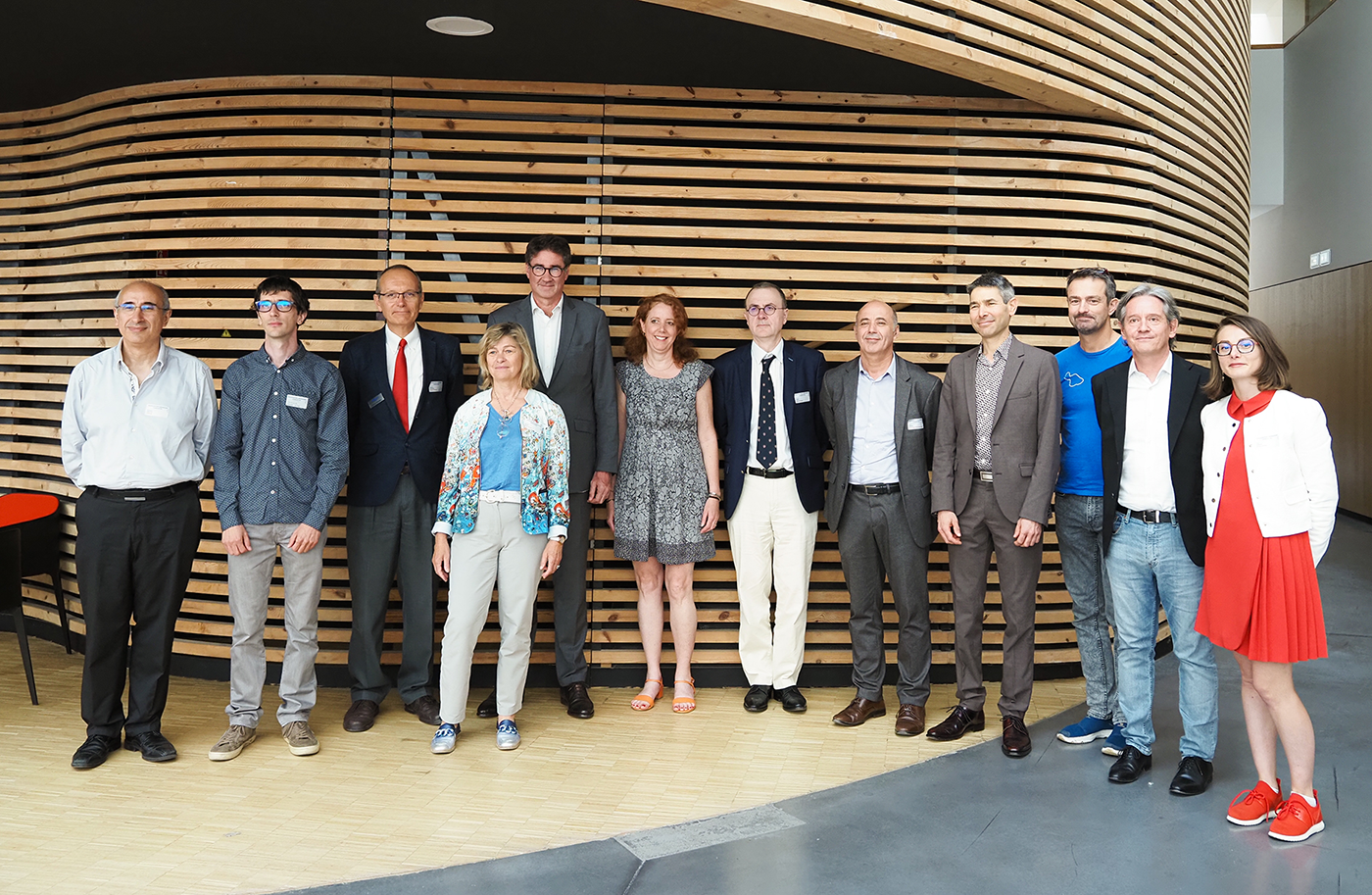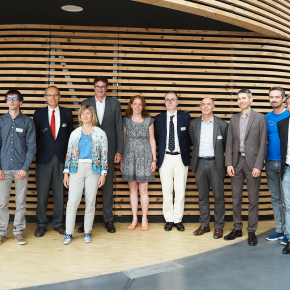
A new collaboration between public and private research studying the electromagnetism of ships
|
Naval Group, a major international actor in naval defence, the CNRS, the Université Grenoble Alpes, and Grenoble INP-UGA inaugurated on 5 July the NEL (Naval Electromagnetism Laboratory) associated laboratory to study the electromagnetic signatures generated by military ships.
This new associated research laboratory will combine the expertise in ship electromagnetism of members from the Grenoble Electrical Engineering Laboratory (CNRS/Université Grenoble Alpes) and the Grenoble Images Speech Signal and Control Laboratory (CNRS/Université Grenoble Alpes), as well as the technical expertise of Naval Group’s R&D teams.
Enhancing control of the electromagnetic signature of ships
By its very presence, a ship creates a local electromagnetic disturbance that can lead to its detection. The sources of this disturbance or “electromagnetic signature” can be the ferromagnetism of the hull, the fields radiated by on-board electronic equipment, and the corrosion currents that form in the water near the hull. Controlling this electromagnetic signature is crucial to ensuring the discretion of military ships, especially in a hostile environment.
The result of longstanding scientific collaboration between teams from Naval Group, the CNRS, the UGA, and Grenoble INP-UGA, the NEL Labcom (Naval Electromagnetism Laboratory) will study the electromagnetism of ships with a view to developing new solutions that ensure discretion in the face of evolving detection methods.
Electromagnetic and acoustic signatures represent a considerable scientific challenge, and are the subject of major research efforts as well as the development of numerous technologies.
A historic scientific collaboration
Relations between public and private actors in this field date back approximately 80 years to when Louis Néel, the winner of the Nobel Prize in Physics in 1970, initiated research during the Second World War on magnetic neutralisation processes for French navy ships.
Since then, the Grenoble research site has acquired internationally recognized expertise, which teams from Naval Group call on regularly. The two entities made their partnership official in 2021 by signing a framework agreement establishing joint research projects, with the subsequent launch of multiple collaborative projects and laboratories. This collaboration is based on the complementary and interdisciplinary scientific skills of the two Grenoble laboratories, including:
- Low magnetic field metrology1
- Modelling low frequency electromagnetic fields
- Processing very noisy magnetic signals for detection
The creation of the NEL associated laboratory provides an enduring and structural framework for collaboration between Naval Group and the laboratories under the joint supervisory authority of the CNRS and the Université Grenoble Alpes in which Grenoble INP-UGA is strongly involved.
“The CNRS is thrilled about the creation of the NEL associated library with Naval Group, with which our organisation has a long tradition of research collaboration, one that is particularly dynamic at the Grenoble research site. The NEL will deepen study of the electromagnetic signature of ships by mobilising the skills and infrastructure of the two Grenoble laboratories under CNRS supervisory authority. The CNRS is proud to contribute to advancing knowledge and enhancing Naval Group’s skills, as part of the enduring framework of an associated library embodying years of relations marked by trust,” declares Jean-Luc Moullet, the CNRS Chief Innovation Officer.
“The NEL associated laboratory, a model of collaboration between public research and industry, is based on multiple pillars: enduring relations, unique experimental resources, dedicated software tools, and of course the skills of remarkable scientists, growing out of a long scientific and experimental tradition. For Naval Group, this ambitious research programme is a major advantage in improving our grasp of the electromagnetic signature of our ships, thereby giving them technological superiority in combat to the benefit of our client navies, chief among them the French navy,” explains Frédéric Vignal, Head of Development and Innovation of Naval Group.
“The Université Grenoble Alpes pursues an ambitious policy supporting innovation and strengthening ties between training, research, and industry, notably via the structuring of its Grenoble Alpes University Innovation Centre, which brings together all of the partners in the ecosystem. This associated laboratory embodies this policy, as well as the impact of public research in addressing major scientific challenges, competitiveness, and French sovereignty,” adds Yassine Lakhnech, President of the Université Grenoble Alpes.
“Based on the historic collaborations that it both structures and strengthens, the creation of this associated laboratory is clear recognition of the cutting-edge position enjoyed by Grenoble researchers in a strategic domain, based on experimentation platforms that are unique in France. It is also an excellent illustration of the innovation policy we are pursuing with our partners, based on the impact of both French public research and public-private collaboration,” points out Vivien Quéma, President of Grenoble INP – UGA.

About the CNRS
A major player in basic research worldwide, the National Centre for Scientific Research (CNRS) is the only French organisation active in all scientific fields. Its unique position as a multi-specialist enables it to bring together all of the scientific disciplines in order to shed light on and understand the challenges of today's world, in connection with public and socio-economic stakeholders. Together, the different sciences contribute to sustainable progress that benefits society as a whole. (www.cnrs.fr)
About Naval Group
As an international naval defence player, Naval Group is a partner for countries seeking to maintain control of their maritime sovereignty. Naval Group develops innovative solutions to meet its customers’ requirements. Present throughout the entire life cycle of vessels, it designs, produces, integrates, supports and upgrades submarines and surface ships, as well as their systems and equipment, up to and including dismantling. It also provides shipyard and naval base services. As a high-tech company, it draws on its outstanding expertise, unique design and production resources and ability to establish strategic partnerships, in particular within the framework of transfers of technology. Ever mindful of the issues of corporate social responsibility (CSR), Naval Group is a signatory to the United Nations Global Compact. With bases on five continents, the group generates revenue of 4,257 billion euros and has 16 325 employees (average annual full-time equivalent workforce - data as of December 31, 2023). (www.naval-group.com)
About the Université Grenoble Alpes (UGA)
Ranked among the top 150 universities worldwide in the Shanghai ranking, deeply rooted in its region, multidisciplinary, and open to the world, UGA is one of the nine French universities labelled as initiatives of excellence (IDEX). Since 2020, UGA has incorporated three component institutions: Grenoble INP, Institute of Engineering and Management-UGA, Sciences Po Grenoble-UGA, and the National School of Architecture of Grenoble ENSAG-UGA, along with three academic divisions: Faculty of Science-UGA, Université School of Technology-UGA, and the Faculty of Humanities, Health, Sports, and Societies-UGA.
With 57,000 students, including over 10,000 international students and 3,000 doctoral candidates, and 7,800 staff members, UGA is spread across several campuses mainly in Grenoble and Valence. National research organisations such as CEA, CNRS, INRAE, Inria, and Inserm are closely associated with the Université Grenoble Alpes to develop a joint research and valorisation policy on an international scale. Relationships with IRD and CHU Grenoble Alpes are also fostered. (www.univ-grenoble-alpes.fr)
Grenoble INP - UGA, Graduate schools of Engineering and Management
Grenoble INP - UGA is a public higher education and research establishment, training creative and responsible students within its 8 schools, committed to a sustainable world in order to address the challenges of transitions. Grenoble INP - UGA develops its training in synergy with high-level research laboratories co-managed with the site's university partners and research organizations (CNRS, Inria, Inrae, CEA, etc.) and has for many years forged close links with the socio‐economic world, which enable it to anticipate their skills needs.(www.grenoble-inp.fr)
- 1The science of measurement. It defines the principles and methods that ensure and maintain confidence in the data generated by measurement processes.


